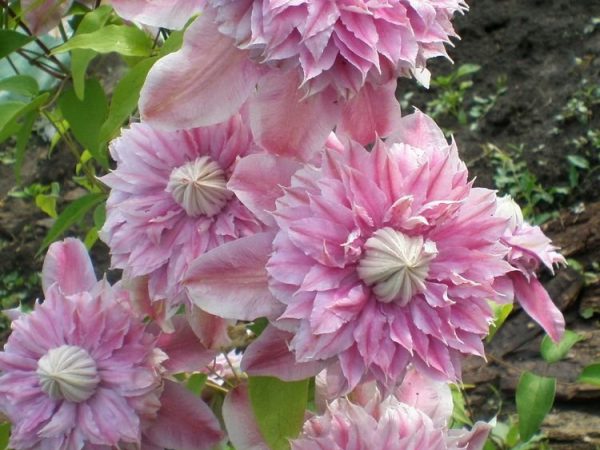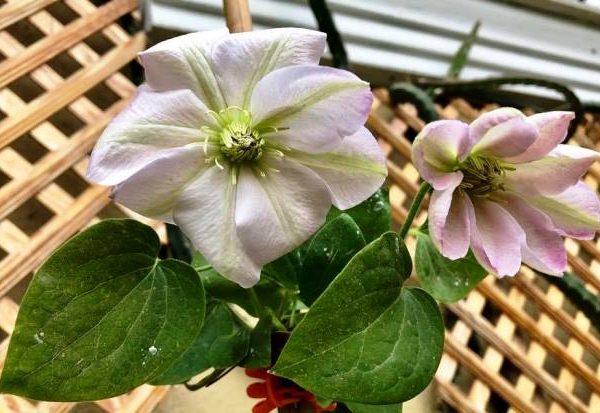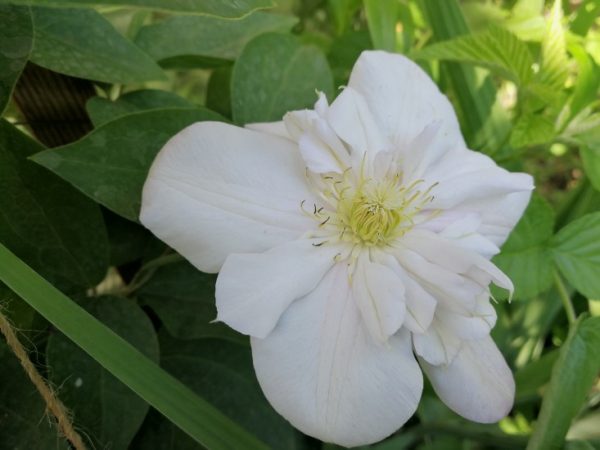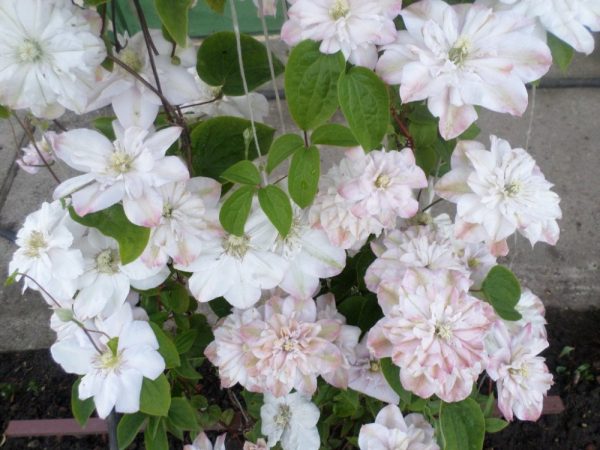Clematis Innocent Blash - general characteristics of the variety
The new hybrid clematis Innocent Blasch (or Bluesch) was bred by Polish breeder Szczepan Marczynski. It differs from other varieties in an unusual structure and color of buds. Consider the main characteristics of the variety, the rules for its cultivation and care.
- Description of the variety
- Landing rules
- Timing
- Seat selection
- Preparation of planting material
- Landing technology
- Care requirements
- Watering
- Top dressing
- Pruning
- Preparing for winter
- Reproduction
- Cuttings
- Stem layering
- By dividing the root
- Diseases and pests
- Application in garden design
- Gardeners reviews
- Useful videos

Clematis innocent blush
Description of the variety
Clematis innocent blush is a large-flowered variety. It blooms twice a year: from May to June, double buds bloom on last year's branches, from July to September, simple flowers develop on a young growth.
Perennial liana compact - stems extend up to 2 m. Shoots are thin, tough, dark brown or purple. The leaves are bright green, oval with a sharp tip;
The inflorescences are large - up to 18 cm in diameter. The petals are arranged in several rows - marginal large, closer to the center - small.
The color is pearl pink, near the core is cream. On young petals, there is a light green vein in the middle.
Landing rules
To achieve high decorativeness from this large-flowered clematis, it is necessary to purchase high-quality material, plant it in a good place and on fertile land.

Clematis innocent blush
Timing
The best time to disembark is mid to late April. By this time, the threat of return frosts has passed and the soil will warm up well.
In the south and in the Middle Lane, autumn planting is allowed - until the last days of September, so that the seedlings have time to get stronger and prepare for wintering.
Seat selection
It is necessary to plant this shrub from the south-west or south-east side of the garden, where there is shading at lunchtime.
Under the sun, the vine will quickly burn out and dry out. If planted in full shade, the flowering will be sparse and less lush, and the foliage will turn pale.
For perennial clematis, a stable support is needed, so it should be planted near an arch, pergola, at a distance of 50 cm from the walls of a house or outbuilding. So the lashes will grow freely and stretch to the top, and the root system will fully develop.
The soil requires light, well-drained with a neutral acidity level - 6 units. If the indicator is higher, 400 g / m² of any deoxidizer should be added: use slaked lime, chalk or calcite.
If cultivation is planned on knocked down clay soil, it is necessary to improve its structure - add 20 to sand, perlite or vermiculite. When planting on sandy loam soil, a couple of clay buckets are introduced.
After adding all the components, the site is dug up, leveled and watered.
Preparation of planting material
You can buy a seedling in a gardening nursery, the main thing is that it is strong and healthy.
You can determine the state of a quality plant by its appearance:
- the stems are flexible, whole, without any mechanical damage and signs of infection with diseases;
- leaves and buds are fresh, solid green.
Choose grown specimens with several branches, densely covered with leaves. They have a well-developed rhizome, so they will successfully take root after planting in open ground.
Clematis seedlings are sold in an earthen coma or in a container. So their root system is protected from drying out. Before planting, the roots are dipped in cold water for 2 hours, then cut to 2-3 cm in length. This is necessary so that the plant planted in the garden begins to grow new roots faster.
Landing technology
Pits are dug a couple of weeks before the planned planting so that the soil and nutrients have time to settle. The distance between the holes is at least 1 m.The approximate depth is 60 cm, the width is 50 cm.

Clematis innocent blasch photo and description
A mixture of pebbles, screenings and brick chips is poured into 1/3 of the volume. Then it is half filled with fertile soil. Mix a bucket of dug earth with 5 kg of compost (last year's manure), 0.3 kg of wood ash, 100 g of superphosphate and 80 g of potassium nitrate.
The nutrient composition is tamped, a hole is pulled out in the center, the rhizome is lowered into it. If a bush with lignified stems, the root collar is deepened by 10-12 cm. When planting a plant with green shoots, it should be 2-3 cm above the ground.
The roots are covered with the remaining soil mixture, compacted, watered - 20 liters of water are poured under one seedling.
To prevent rapid evaporation of moisture and drying out of the superficial root system, mulch from peat, sawdust or leaf compost is introduced into the trunk circle.
Care requirements
After planting, the seedlings must be shaded from the scorching sun, otherwise they will dry out and die in a few days. Use burlap or agrofiber.

Clematis innocent glance photo
Watering
This is a moisture-loving culture, but it does not tolerate excess moisture, therefore it is often moisturized, but moderately. In the first month, the bushes are watered every day, provided that there is no rainfall. Moisture will help them take root faster and start growing. Further, as the surface layer of the earth dries up to a depth of 5-6 cm.
Mature shrubs that are in bloom need to be moisturized several times per season:
- in early spring before the buds begin to bloom;
- before the formation of buds;
- after flowering;
- in the fall, when the plant sheds its leaves.
Water consumption for each watering is at least 30 liters.
It is not necessary to loosen the soil, since there is a high risk of damage to the superficial root system. It is necessary to regularly remove weeds, weed the soil between the rows. You also need to add mulch, which will prevent rapid evaporation of moisture. For this purpose, peat and sawdust are used.
Top dressing
The nutrients laid down during planting will be enough for the seedlings for three years. After clematis, you need to fertilize every year and several times per season.
- In the spring, before the start of sap flow, the near-stem circle is watered with a solution of urea, ammonium nitrate or nitrophoska. Dissolve 15 g of the substance in a bucket of water. 5 liters of working fluid are poured under one bush.
- Until the buds bloom, they are fed with a complex composition - 1 tbsp each. l. potassium sulfate and superphosphate per 10 liters of water. Spend 5 liters per plant. The same means can be fertilized as the inflorescences dry out.
- In late autumn, after a massive fall of leaves, compost or last year's manure is embedded in the near-trunk zone - 10 kg per 1 m².
Each food is combined with watering; under the influence of moisture, nutrients are absorbed faster by the roots.
Pruning
This variety belongs to group 2, therefore, a haircut is carried out twice a year:
- the first shortening of last year's branches to 2-4 buds is carried out at the end of flowering;
- the second time, the young growth is pruned after the buds have dried out.
Additionally, during the entire growing season, cut vines growing in the wrong direction or thickening the crown. Also, frozen stems, broken off by the wind, dried out and damaged by diseases, are subject to complete cutting.
For manipulations, a well-sharpened and sterile secateurs are used, and after the procedures, they are irrigated with a solution of copper sulfate.
Preparing for winter
Despite its good frost resistance, at a young age, clematis can easily freeze through even at a slight minus temperature, therefore, it requires insulation.

Clematis innocent glans photo and description
On the eve of autumn frosts, the trunk circle is sprinkled with a thick layer of peat, humus or compost (15 cm). The branches are removed from the supports, tied, bent to the ground, and fixed with staples. Fall asleep with fallen leaves, then cover with spruce branches or burlap.
Under a breathing shelter, the vine will not rot or freeze. The insulation material is removed in the spring, when the snow thaws and the threat of recurrent frosts has passed.
The twigs are pulled on the trellis in the right direction so that in the future the shrub will have a beautiful and compact shape.
Reproduction
There are several breeding options for perennial vines, the main thing is to adhere to the rules for harvesting and planting material, which will give a positive result in the future.
Cuttings
Twigs are cut in spring or summer during a sanitary cut. Apical green cuttings with two internodes, buds and leaves are chosen. Cut off with a knife in an oblique manner, at the bottom they cut off the leaves.
Shoots are dipped for an hour in a solution of Kornevin or Heteroauxin, then planted in a nutrient composition of peat and sand mixed in equal amounts. Close up to a depth of 3-4 cm, watered, covered with transparent film.
They are placed in a warm place with diffused daylight. Every day, the seedlings are ventilated, moistened as necessary. As soon as they release new leaves, they are opened, they continue to look after for another 1-1.5 months, so that they become overgrown with roots. Then they are individually planted in the garden.
Stem layering
In the fall, when the shrub has completely shed its leaves, a long branch is chosen on it, close to the ground. A trench is pulled out nearby, a stem is lowered into it, sprinkled with a mixture of sand, peat and humus (1: 1: 1), watered.
Before frost, they are covered with a thick layer of hay, straw or fallen leaves, spruce branches are laid on top. So the cuttings will not freeze over the winter.
In the spring, when the snow melts, the above zero temperature stabilizes, the vine is dug up, cut off from the bush. Divided into segments with roots. Planted separately in a garden or flower garden.
By dividing the root
Such reproduction is carried out in the spring in order to restore the decorative effect of old bushes and get several new seedlings from them.
The breeding technology is as follows:
- the bush is watered abundantly, dug out after an hour;
- dip the roots into water to wash off the remnants of the earth;
- dried, cut into pieces with a garden shovel, so that each one has several roots, one shoot with buds;
- the places of the cuts are sprinkled with charcoal to prevent infection;
- planted in the same way as purchased seedlings.
Diseases and pests
This variety of clematis is resistant to many types of infections and parasites, but if the rules of maintenance and care are violated, it can easily get sick.

Clematis innocent blush care
- In the treatment of powdery mildew, rust, gray rot, fungicides are used - Azocene, Ridomil gold, Skor, Hom or a solution of copper sulfate. If the vine is affected by wilt disease, it should be dug up and disposed of.
- For pests - aphids and caterpillars - use insecticides. The crown is irrigated with Aktellik, Karbofos or Aktara.
- For slugs and snails, use Thunderstorm or Slug-Eater. Also sprinkle the near-trunk area with wood ash or coniferous sawdust.
For prevention, it is recommended to buy healthy and strong seedlings, avoid thickening when planting, keep the garden clean, remove damaged parts in time, and periodically water and feed. In spring and autumn, the treatment of the shrub and the soil under it with a solution of copper sulfate or Bordeaux liquid is required.
Application in garden design
Perennial vine is used in both single and group plantings. They are planted in combination with other varieties of clematis.

Clematis large-flowered innocent glans
They are used for landscaping arches, arbors, terraces, pergolas and other vertical surfaces.
Combine with low-growing decorative deciduous flowers, as well as ground cover plants.
Gardeners reviews
This variety is especially popular with gardeners:
- due to unpretentious cultivation, cold resistance and good immunity;
- the plant blooms twice a year, which allows you to repeatedly enjoy its grace;
- the culture successfully reproduces in different ways, so you can independently get many new seedlings with all the signs of the mother bush.

